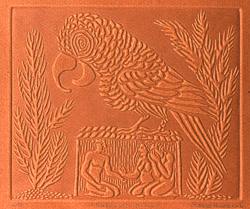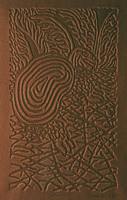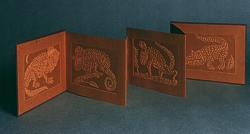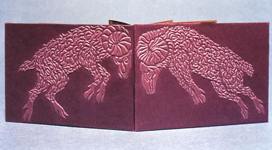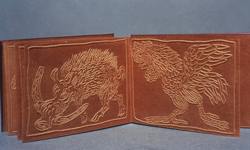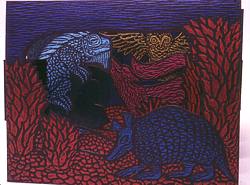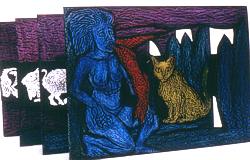 |
|
|
|
|
InPrint Article
Read this article, or see other newsletter articles. May, 2005 Secrets of Embossing Shared by Rand Huebsch As attested by the ancient cylinder seals used to imprint clay tablets, the impulse to make an embossed impression is ages old. For embossing onto paper, a deeply etched metal plate is an ideal matrix. Printing with this plate produces an additional image reversal: its etched areas create the raises of the paper bas relief, while its unbitten, higher areas provide the paper’s recesses. Creating the Plate: Reductive Approach The reductive approach is a variant of traditional etching: one uses a stylus to remove areas of protective coating, or ground, from the plate, which will then be "carved" by the acid. (While I prefer to work with 16-gauge copper, other metals can be used.) To start, brush ground onto a thoroughly degreased plate that has an acid-resistant backing on the other side. As the plate will be bitten for many hours, use a sturdy resist such as asphaltum or a mixture of it and liquid hard ground; don’t apply the resist too thickly, or it will not dry thoroughly. When the ground has dried, you can draw image guidelines onto the plate. In conceiving the image, keep in mind that the lines of the embossed print can be raised or recessed, or a combination of the two techniques can be used, just as a woodcut can have both black and white line. You can draw directly on the grounded plate with white crayon; I like water-based Caran d’Ache. Or, to transfer a sketch (preferably on tracing paper), use a light-colored transfer paper, such as Saral, or make one by rubbing chalk onto the reverse side of the drawing. Tape the drawing to the plate so that it does not shift while you do the transfer: place the transfer paper under it, powder-side down, and re-draw the image with a hard-lead pencil.
If the guidelines are for a raised-line image, you will need to decide how much metal to expose by repeated passes of the stylus. Conversely, if a line denotes a recessed area, determine how much ground to scrape away on each side of it. Those choices are largely intuitive and arise out of the process and the context. Use a broader stylus to clear larger areas. Scrape away ground thoroughly and whisk off the particles with a piece of paper towel. For an alternative ground, experiment with contact paper, which holds up very well during a long etch. Adhere it to the bare plate and draw guidelines with a water-based crayon. Then, as if doing a paper cut, use an X-acto knife to remove the paper from those areas to be etched; then make sure to scrape any adhesive traces from the exposed metal. Creating the Plate: Additive Approach With the additive method, one brushes asphaltum lines on to the bare metal: the resulting prints contain an effective contrast between the spontaneous motion of the brush stroke and the sculpted look that embossings have. For this method, it is crucial to start with a well-degreased plate, onto which you can directly draw guidelines with a dark water-based crayon. To transfer a drawing on tracing paper, coat the reverse side of the paper with litho crayon, then put that side in contact with the bare plate for the transfer. As your metal plate is only about an eighth of an inch thick, it should not have any very large open areas of metal: they will not register as raised in relation to the surrounding elements.
When painting, experiment with various combinations of asphaltum and liquid ground to find the consistency that works best for you. The ground will spread slightly when it is applied, so choose your brush accordingly and, for better control, charge it with only a small amount of ground for each stroke; experiment with different brushes. When the lines have dried, you can refine them with a stylus. As the additive approach requires a longer exposure of the artist to fumes, good ventilation is especially important; in addition to having windows open while working, I use a fan to blow away fumes, and I take breaks. Biting the Plate Although most mordants are suitable, I use ferric chloride, either undiluted (42 degrees Baume), or diluted 1:1. Because there are so many variables in biting, such as acid strength and the desired depth of bite, there is no precise formula for etching time. Using fresh ferric (1:1) and with the plate face down, I have found that a 10- to 15-hour bite has usually provided the results that I wanted. When the plate is etched face down, the bite is crisper and faster and the edges of ground seem to hold up better, possibly because the partitions are not undercut. Affix water-resistant supports, such as bits of wax, to non-image areas of the plate so that it does not rest directly on the bottom of the tray; for that purpose, you can reserve a margin of grounded metal, which will later be cut away. It is important to check the biting plate at least once an hour, as residue should be removed and areas of ground can break down. Rinse the plate under a soft flow of water and gently blot it dry; then touch up those areas that need it. During the course of the biting process, you may wish to selectively stop out some exposed areas. Generally I have not worked that way, but instead have allowed all of the original open areas to bite for the same period of time. Note that, on a plate with open-bite lines of varying widths, the thicker lines will bite more deeply than the thinner ones. To re-coat a plate that has been proofed and needs additional biting, you can either brush the ground lightly over the surface or roll up a brayer with asphaltum and apply to the plate. When the ground is dry, scrape away any that has dripped onto open-bite areas. If there are small sections of the plate that you feel should not have been etched, you can fill them with air-hardening clay. Printing After cleaning the plate of ground, you can proof it; sometimes it is possible to proof a contact-papered plate without damaging the covering. While making the plate is time consuming, printing it on the etching press goes quickly, as there is no inking required. Essential for emboss printing is a sheet of foam rubber, placed between the plate and the etching blanket; this serves both to help push the paper into the plate’s recesses and to protect the blanket from being embossed. Use somewhat greater pressure than usual; too much, however, can actually lessen the relief areas and also cause the paper to tear. As you will be using foam rubber and a blanket, some trial and error will be involved.
When I first started to make embossings, I discovered that Canson mi-teinte pastel papers work well, especially the middle-value colors. When embossed, they undergo a slight lightening of color in the raised areas and take on a leather-like look that makes them especially suitable as covers for artist books. I quickly dampen them in the paper-soak tray, then sponge and blot them. Even the heavier printing papers do not need to be soaked for long, as they are not required to absorb ink. To keep the print from buckling, I pin it to cork board with push pins at two- or three-inch intervals along a border of paper that is trimmed off once the print has dried. Alternatively, the print can be put under medium weights for drying and it will not be flattened. Image: Concept and Variation In making an embossing plate, you are creating a network of partitions and compartments; thus the process is not ideal for replicating a tonal crayon drawing. For ideas, study the stylization in carvings from various cultures. For example, in ancient Egyptian stone reliefs a human figure is usually lower than the surrounding area and is stylized such that the head is in profile, the torso is facing the viewer and the legs are in side view. In addition, look at Mayan and Aztec friezes, Medieval ivories, and Renaissance commemorative medallions, and apply to your work some of their figure/background conventions. It can be helpful to draw on gray paper, with pencil line, while heightening in white those areas that correspond to the reliefs in the print. As bas reliefs, embossings are best presented with a strong raking light on one side to maximize the cast shadow. Once you have made the printing plate, explore the variations. Certainly you can relief ink the plate, woodcut-style, and either print it by hand or on a press. I have hand-colored embossings on dark paper by rubbing them with angled Caran d’Ache crayons so that only the raised areas of paper change color, in the manner of tomb rubbings. Embossings can be used effectively in the accordion book format, as they will provide an image for both sides of the book. For a surface sheen, you can apply white glue to a print; this will also protect the piece if it is to be handled often. I have embossed onto very thin metal sheets and, in a nod to the ancient cylinder seals, have pressed flattened slabs of clay into the metal matrix to make plaques. The etched plates are themselves sculptural pieces that can be displayed. About the Author: Rand Huebsch is a printmaker and co-founder of the Manhattan Graphics Center. His artist’s books are in the collections of the Victoria and Albert Museum, the Detroit Institute of Arts, and the Fogg Art Museum, among others. Contact him at rahuebsch@earthlink.net. Additional information and illustrations are available at www.philobiblon.com/bonefolder/BonefolderVol1No2.pdf. |
||||||||
Site hosting and maintenance courtesy of
